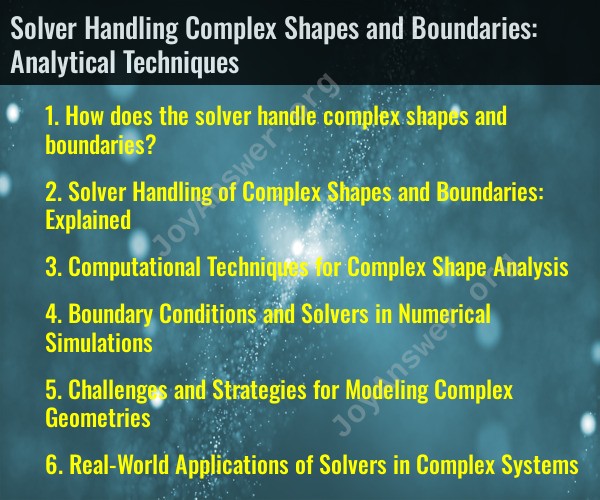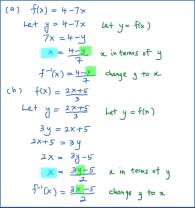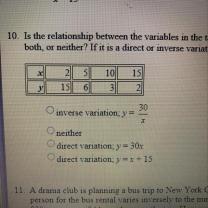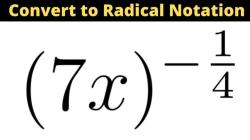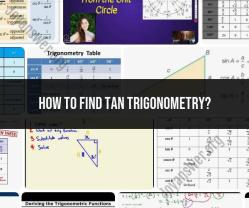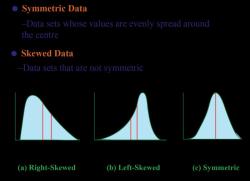How does the solver handle complex shapes and boundaries?
The way a solver handles complex shapes and boundaries depends on the specific type of problem it is designed to solve, but there are some general analytical techniques and numerical methods that can be employed to address complex geometries and boundaries in various fields, such as computational fluid dynamics, heat transfer, and structural analysis. Here are some common approaches:
Meshing: Most solvers use meshing to discretize complex geometries into smaller elements or cells. Meshing involves dividing the domain into finite elements (e.g., triangles, quadrilaterals, or tetrahedra) or finite volumes. The quality of the mesh, the type of elements used, and the resolution near boundaries can significantly impact the solver's accuracy.
Boundary Conditions: Accurate boundary conditions are essential for solving complex problems. Different types of boundary conditions (e.g., Dirichlet, Neumann, or mixed conditions) are applied to specify values or gradients of the solution at boundaries. These conditions are often essential for solving partial differential equations.
Domain Decomposition: In some cases, complex domains can be divided into smaller, more manageable subdomains. This technique, known as domain decomposition, simplifies the problem and allows for parallel processing.
Adaptive Mesh Refinement: Adaptive mesh refinement involves refining or coarsening the mesh locally in areas where the solution varies rapidly or is of particular interest. This approach allows solvers to focus computational resources where they are needed most.
Embedded Boundary Methods: In problems involving solid-fluid interactions or complex boundaries, embedded boundary methods can be used. These methods allow the solver to handle irregular or moving boundaries by tracking the interface between two different materials or phases.
Level-Set Methods: Level-set methods are used to represent and track boundaries or interfaces in fluid-structure interaction problems. They are particularly useful for problems with complex, evolving interfaces.
Immersed Boundary Methods: Immersed boundary methods are often employed to simulate the flow around complex, solid boundaries, such as buildings or biological organisms. These methods incorporate the influence of boundaries on the fluid flow without the need for a conforming mesh.
Cut-Cell Methods: Cut-cell methods are used in grid-based solvers to handle complex geometries. They involve cutting through grid cells to account for the presence of solid boundaries.
Boundary Element Methods: In structural analysis or potential flow problems, boundary element methods (BEM) can be used to directly solve problems on the boundary itself. This avoids the need for volumetric meshing.
Isogeometric Analysis: Isogeometric analysis (IGA) is an emerging technique that uses high-degree B-spline or NURBS curves and surfaces to represent complex geometries. It allows for more accurate representation of boundaries and is used in both structural and fluid analysis.
Hybrid Methods: In some cases, a combination of the above techniques may be employed to handle complex geometries. For example, a solver may use adaptive mesh refinement along with embedded boundary methods to handle fluid-structure interaction problems.
The choice of which technique to use depends on the specific problem and its requirements, the available computational resources, and the expertise of the user. In practice, complex geometries and boundaries are common in engineering and scientific simulations, and the development of advanced numerical methods and solver techniques has made it possible to address a wide range of complex problems accurately.
Solver Handling of Complex Shapes and Boundaries: Explained
Solvers are numerical algorithms used to solve differential equations. They are essential for modeling and simulating complex systems, such as those found in engineering, physics, and biology.
One of the key challenges in solver development is handling complex shapes and boundaries. Complex shapes can be difficult to discretize into a mesh, which is required for numerical simulations. Boundaries can also be complex, with sharp corners and irregular shapes.
Computational Techniques for Complex Shape Analysis
There are a number of computational techniques for complex shape analysis, including:
- Mesh generation: Mesh generation is the process of dividing a complex shape into a mesh of simpler shapes, such as triangles, tetrahedra, or hexahedra.
- Boundary representation (B-rep): B-rep is a geometric modeling technique that represents shapes using surfaces and curves.
- Level set methods: Level set methods are a numerical method for tracking the evolution of interfaces between different materials.
Boundary Conditions and Solvers in Numerical Simulations
Boundary conditions are the conditions that the solution to a differential equation must satisfy at the boundaries of the domain. Boundary conditions are essential for ensuring that the solution is physically meaningful.
Solvers use boundary conditions to constrain the solution to the differential equation. For example, a solver might use a Dirichlet boundary condition to specify the value of the solution at the boundary.
Challenges and Strategies for Modeling Complex Geometries
Some of the challenges in modeling complex geometries include:
- Mesh generation: It can be difficult to generate a mesh for a complex shape that is both accurate and efficient.
- Boundary conditions: It can be difficult to specify accurate boundary conditions for a complex shape.
- Computational cost: Simulating complex geometries can be computationally expensive.
Some of the strategies for modeling complex geometries include:
- Adaptive meshing: Adaptive meshing is a technique that dynamically refines the mesh in regions where the solution is rapidly changing.
- Immersed boundary methods: Immersed boundary methods allow for the simulation of complex geometries without having to generate a mesh for the entire geometry.
- Parallel computing: Parallel computing can be used to speed up the simulation of complex geometries.
Real-World Applications of Solvers in Complex Systems
Solvers are used in a wide range of real-world applications, including:
- Aerodynamics: Solvers are used to simulate the flow of air around aircraft and other vehicles.
- Fluid dynamics: Solvers are used to simulate the flow of fluids, such as water and oil.
- Heat transfer: Solvers are used to simulate the transfer of heat in solids and fluids.
- Structural mechanics: Solvers are used to simulate the behavior of structures under load.
Solvers are essential tools for modeling and simulating complex systems. They are used in a wide range of industries, including aerospace, automotive, and manufacturing.
Here are some specific examples of how solvers are used in real-world applications:
- Simulating the spread of a wildfire: Solvers can be used to simulate the spread of a wildfire through a forest. This information can be used to develop strategies for fighting wildfires.
- Designing a new aircraft: Solvers can be used to simulate the flow of air around a new aircraft design. This information can be used to optimize the design of the aircraft and improve its performance.
- Predicting the weather: Solvers are used to predict the weather by simulating the atmosphere and its dynamics. This information can be used to warn people about severe weather events and help them make decisions about their daily lives.
Solvers are powerful tools that can be used to solve a wide range of problems in science and engineering.
